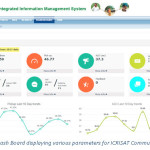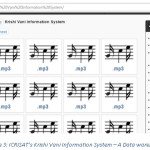Assessing the Effect of Participatory Approach for Delivering Agricultural Information Service (AIS) to Smallholder Farmers
V. V. Sumanthkumar1, Nilesh Mishra2, Kanika Singh3, P. Vijaya Raju4 and Madhu Babu5
1Scientist - ICT4D, International Crops Research Institute for the Semi-Arid Tropics (ICRISAT), Patancheru, Hyderabad.
2Senior Scientific Officer- ICT, International Crops Research Institute for the Semi-Arid Tropics (ICRISAT)
3Program Executive, FTF-ITT, National Institute of Agricultural Extension Management (MANAGE)
4Research Scholar, ICRISAT
5Senior Content Manager, IFFCO Kisan Sanchar Limited (IKSL)
Corresponding author Email: v.sumanth@cgiar.org
Article Publishing History
Article Received on :
Article Accepted on :
Article Published :
Plagiarism Check: Yes
Article Metrics
ABSTRACT:
Information has been described as the fifth most important need of mankind ranking after air, water, food and shelter.” - Kemp (1976) and we believe smallholder farmers are no different. In fact, in addition to other key inputs (such as improved seed variety, micro and macronutrients etc.) access to correct, timely and actionable information (in this case scientifically supported farming practices that include but are not limited to date of sowing, irrigation, harvesting, better price, market etc.) can be considered as a critical factor in achieving better yield and thereby higher profits. Source of this information is also a critical factor in acceptance and adoption of these information. For instance, a report published in 2005 by National Sample Survey Organization (NSSO, 2005), a government of India entity, highlights that most preferred source for agricultural information services for smallholder farmers are their fellow farmers. Reports suggest that participatory approach in video based agriculture extension has proved to be more effective as compared to traditional extension method but there is not much or limited evidence of same for audio based dissemination of agricultural information services (AIS).
In the above backdrop and taking this fact into consideration a team of researchers at ICRISAT along with its partners conducted a research to study the effect participatory approach for delivering agricultural information services to smallholder farmers. Where in, improved and scientifically supported farming practices were recorded as small audio capsule in participating farmer’s voice and were periodically delivered to other farmers who were part of this research study. During the study, it was found that agricultural information services, to be delivered, when recorded in farmers own voice from the same farming community creates excitement for the fellow farmers and positively affects the listening pattern of those messages. This in turn translates into increased adoption, better yield and higher profit.
KEYWORDS:
Participatory approach; Agricultural Information Service; listening pattern; messages
Copy the following to cite this article:
Sumanthkumar V. V , Mishra N, Singh K, Raju P. V, Babu M. Assessing the Effect of Participatory Approach for Delivering Agricultural Information Service (AIS) to Smallholder Farmers. Orient.J. Comp. Sci. and Technol;9(3)
|
Copy the following to cite this URL:
Sumanthkumar V. V , Mishra N, Singh K, Raju P. V, Babu M. Assessing the Effect of Participatory Approach for Delivering Agricultural Information Service (AIS) to Smallholder Farmers. Orient. J. Comp. Sci. and Technol;9(3). Available from: http://www.computerscijournal.org/?p=6023
|
Introduction
India’s telephone subscriber base reached 1,058.86 million in March 2016 with close share of 57.6 per cent to 42.4 per cent of subscription base of urban and rural regions respectively (TRAI, IBEF). A rural population of 833 million (Census of India, 2011) implies that every second person in rural India owns a mobile phone. A recent study by NSSO highlights that rural India spends most on mobiles and that technology is making inroads into villages. According to NSSO data, people of rural India spend most on the use of mobile phones and telephones among all services, accounting for 25.33 per cent. The study also highlights that in terms of Monthly Per Capita Expenditure (MPCE) also, the highest amount went to communication services – Rs 36.35 in rural and Rs 102.46 in urban areas. The rural-urban gap has closed when it comes to communication services. While people in the villages spend about 25.33 per cent of their budget on this, urban families are marginally ahead at 26.33 per cent. Given these statistics and the extremely low cost of transmitting information over a mobile network, the mobile phone emerged as the number one choice to deliver the agricultural information services (AIS) to address their information deficit needs. Mobile phones have the potential to deliver information to the farmer on demand rather than the farmer spending time in searching and procuring information. During peak agriculture seasons farmers cannot spend time procuring information without affecting their farming activities negatively. There are information search costs associated with each step in the chain of agricultural activities. These costs can be as high as 70 percent of all transaction costs, while transaction costs themselves are 15 percent of all costs incurred (Banerjee, S. 2013). Thus, lack of information is considered to be a major impediment to improving farmers’ livelihoods. To reach out to farmers with information about new tools, technologies and agricultural practices, the Government of India has in place a large workforce of extension agents. The agents reach out to farmers through various means, such as, one-on-one contact, farmer field days, farmer schools, wall writings, distribution of pamphlets/leaflets, and various other means to disseminate information and provide advice. In addition to the extension network, other sources of information for the farmer are peer-to-peer sharing, traders/intermediaries and input service providers especially for seeds and fertilizers. The source of information is very critical when it comes to adoption of suggested/recommended good agricultural practices (GAP) and a study by NSSO suggests that fellow progressive farmers have been the most preferred source of information access by the smallholder farmers. Moreover, digitally available public information related to agriculture is generally poor in quantity and generic in quality (Balaji 2009).
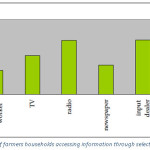 |
Figure 1: Percentage of farmers households accessing information through selected sources (NSSO, 2005)
Click here to View figure
|
The above mentioned limitations interact and reinforce each other to limit the information reaching the farmers. This creates a large potential for mobile-phone-enabled extension systems to improve farmers’ access to knowledge. Thus, the earliest uses of mobile telephony in agriculture were providing extension services through mobile phones.
ICTs for agriculture in India
India has always been at the forefront in using Information and Communication Technologies (ICTs)[1] for agriculture and some of the very early interventions dates way back to 1998, to name a few Warna Wired village (1998), Gyandoot (2000), Nokia Life (2009), Reuters Market Light (2007), e-Sagu (2004), e-Krishi, e-Choupal and iKisan etc. These initiatives provided information across range of subjects which were not limited only to agriculture, such as: Gyandoot, Warna Wired Village and Nokia Life also provided information on other aspects like education, health, entertainment, provision of government services like birth/death certificates, copies of land titles, information on government schemes, government subsidies, and a variety of other information and services. The information delivery channels used by these initiatives were: (i) operator-mediated computer kiosk; (ii) telephony (call centers and mobile phones); (iii) web portals and (iv) different combinations of first three channels.
[1]ICTs include all forms of modern communication technologies like radio, television, community radio, operator-mediated computer kiosks, websites, mobile phones and other hand-held devices.
Mode and source of Information delivery
Mobile application plays a key role in fulfilling the agricultural information needs of the farmers as it has many advantages such as easy and convenient access, reach to areas where there is no other ICT infrastructure like internet, fixed lines etc., and is easily afforded by farmers (Ravinder and Vister, 2010). Many researchers have convincing argued that mobile phones are more important than PC based system in developing countries (Duncombe & Heeks, 1999; Donner 2006; Rashid & Elder , 2009). Jensen’s (2007) study in the state of kerala, India, showed that adoption of mobile phones by fishermen translated into direct economic benefits. Despite the number of services and service providers for delivering agricultural information services, mode and source of information delivery have remained concerns.
Use of Text SMS
Given the low levels of literacy in rural India, there are concerns whether text messages are the most appropriate form of providing information. To overcome the literacy barrier some service providers rely on providing voice messages.
Use of local language to deliver voice message
India is home to several hundred languages of which 23 are constitutionally recognized. Hence, the choice of the SMS language is another concern. English is the default language supported by all mobile handsets. However, it is not the most suitable language for communicating with farmers. SMS in local languages has been tried by some service providers, but the old, beat-up feature phones owned by farmers do not support local language SMS[1]. Though the situation is now improving with more handset manufacturers incorporating local language support in basic low-cost feature phones, it still involves farmers buying these new phones which may not take place until a natural replacement occurs.
Source and location specific Information
Referring to the above situation, about the preferred source of information access and voice based information delivery through mobile phones being the primary and most apt mode, it becomes empirical to use participatory approach by involving farmers to develop location specific voice messages on good agricultural practices and delivery to the targeted farming community in the region. To test this concept a group of researcher from ICRISAT along with its strategic partners IKSL and AF Ecology Centre of RDT conducted a study at Anantpur where a group of approx. 5000 farmers formed a community to implement Krishi Vani information services.
[1]Author’s observations during a field visit to a SMS-based crop sowing advisory project in Kurnool district of Andhra Pradesh, India.
Anantapur is the largest district of the state with 64 Mandals (Administrative Divisions) located southern Andhra Pradesh in South India. It is known for being the district with the second lowest rainfall in India and lowest in Andhra Pradesh. Farmers depend on drought prone, rain-fed agriculture and mostly groundnut is sown as a major crop under such harsh and agro-climatic conditions. Anantapur has a semi-arid climate, with hot and dry conditions for most of the year. The sex ratio was 995 females per 1000 males and 9% of the population was under six years old. Effective literacy is 82%, male literacy is 89% and female literacy is 75%. The economy is principally agrarian with very few industries. Prominent crops include groundnut, jowar, maize, rice, cotton and sunflower. With very little rainfall, the district is one of the most backward provinces in the state and indicated in its severe rural indebtedness, high seasonal migration and highest number of farmers suicides in the country. About 20% of the population comprises Dalit and tribal people, and 60% of backward communities. Malnutrition, illiteracy, illness, deprivation and caste and gender discrimination are rampant here.
The experiment
ICRISAT has partnered with IFFCO Kisan Sanchar Limited (IKSL) and AF Ecology center to develop and sustain Krishi Vani Information service. IKSL has provided a robust mobile based information dissemination platform by which ICRISAT communicates to its community of farmers. The ground activities were coordinated by AF Ecology center of RDT who has physical presence in Anantpur. AF Ecology Centre is working with about 60000 small & marginal farmers and farm labor spread across 230 villages in 8 mandals (out of 63 mandals) in Anantpur district. IKSL has developed a Dash Board to capture the statistics related to the voice messages pushed to the farmers. The IKSL Platform calculates various parameters like Pickup%, OBD, Average Listening Duration of entire community and make it available in a comprehensive manner using an inbuilt dash board which is shown below.
ICRISAT has developed Krishi Vani information system – a Master data warehouse of messages for all locations where ICRISAT operations are present. A web interface also developed to enable IKSL easy access of these messages for further pushing to the farmers, to carry this study.
Discussion & conclusion
Over a period of around 2 months, 12 voice message were sent to the farmers via Krishi Vani Information System in local language Telugu. The voice messages ranged from different crops and different pests/agronomic practices relevant to current season and the location Anantpur.
Table 1: List of messages send to the selected group of farmers over the period of 2 months
|
Broadcast Date
|
Title
|
|
5/18/2015
|
Advisory Advice for Dry Remedies on Corn Crops
|
|
5/20/2015
|
Details of Paddy Paddy Prevention
|
|
6/2/2015
|
About A.F. on the method of avoiding tobacco mite in organic farming. Advisory Advisory by EKCC Central
|
|
6/3/2015
|
The process of ripening rice in the urea solution
|
|
6/5/2015
|
About A.F. on the method of avoiding tobacco mite in organic farming. Advisory Advisory by EKCC Central
|
|
6/6/2015
|
uses of cattle with multi-purpose millet
|
|
6/8/2015
|
The process of ripening rice in the urea solution
|
|
6/9/2015
|
Benefits of crops exchange
|
|
6/19/2015
|
The process of ripening rice in the urea solution
|
|
6/20/2015
|
Prophylaxis method
|
|
6/27/2015
|
Prophylaxis method
|
|
6/29/2015
|
Poultry manure used in crop
|
The data recorded by the IKSL server gave some interesting insights on the listening pattern and call pick-up rate by the focused farmers group, from the comparative study of the voice messages were recorded in Voice over artist’s voice to that of farmer’s voice from the same community.
Table 2: Pickup rate and average listening duration when voice messages recorded in Voice over artist’s voice
|
Voice Over Artist
|
|
Pick up%
|
Average Listening Duration
|
|
57.37
|
45.8
|
|
58.13
|
44.3
|
|
54.31
|
44.2
|
|
57.46
|
44.7
|
|
57.92
|
40.3
|
|
56.5
|
44.7
|
|
56.47
|
45.9
|
|
57.93
|
43.8
|
|
54.12
|
44.4
|
|
50.25
|
44.3
|
|
52.4
|
44.4
|
|
54.94
|
48.9
|
Table 3: Pickup rate and average listening duration when voice messages recorded in farmers voice
|
Farmers Voice
|
|
Pick up%
|
Average Listening Duration
|
|
65.37
|
55.1
|
|
69.16
|
57.5
|
|
66.2
|
54.2
|
|
69.29
|
55.8
|
|
69.4
|
54.7
|
|
68.21
|
54.6
|
|
63.29
|
57.3
|
|
68.92
|
53.6
|
|
63.37
|
56.2
|
|
67.22
|
57.8
|
|
70.7
|
58.1
|
|
63.14
|
56.5
|
It was observed that the messages recorded in farmer’s voice from the same community witnessed increased call pickup rate with increased listening duration as compared to that of voice over artists.
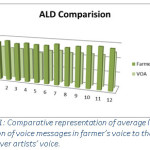 |
Figure 1a: Comparative representation of average listening duration of voice messages in farmer’s voice to that of the Voice over artists’ voice.
Click here to View figure
|
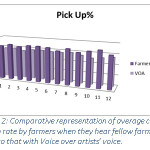 |
Figure 2a: Comparative representation of average call pickup rate by farmers when they hear fellow farmers voice to that with Voice over artists’ voice.
Click here to View figure
|
While it was an experiment conducted on small target group of farmers, the comparative results and data suggests that the participatory approach of developing the information have shown an increase of around 11.3 per cent both in the phone pickup rate and in average listening duration. The results and outcome of suggests that farmers to farmers mode of knowledge transfer is still very effective and plays a key role in information sharing from one farmer to other. It can also be noted that human intervention still proves to be an effective enabler and enhances the chance of increased adoption of advisory services by the smallholder farmers.
Referring to the above outcomes, following key points can be takin into consideration while designing and ICT mediated Information delivery solutions for smallholder farmers:
- Source and mode of information delivery is critical and should be taken into consideration, while designing ICT solutions.
- Participatory approach can play as an enabler and so it becomes important to involve the farmers’/lead farmers from the same community when developing such solutions for smallholder farmers.
- Local languages again play critical role in getting heard the intended message and follow up on the actionable recommendations.
- Also, region specific information goes a long way especially while dealing with agricultural information delivery for smallholders.
Recently, with the massive cut in internet, data charges and increased access to mobile phones even at the rural level location specific, voice based ICT tools in local language can be designed to address the information need gap of smallholder farmers. These information needs can range from farm to fork i.e.: quality inputs, better variety seeds, fertilizers, weather advisory, crop pest management, harvesting time, better market & price and so on.
References
- Kemp, D. A. (1976), “Nature of knowledge: and introduction for librarians”; Clive Bingley, London.
- IBEF. 2017, Sectoral Report: Industry- telecommunications https://www.ibef.org/industry/telecommunications.aspx
- Indiatoday, Rural India spends most on mobiles: NSSO. News http://indiatoday.intoday.in/story/rural-india-technonology-mobile-phones-national-survey/1/710883.html accessed on 25 May, 2017
- Rikin Gandhi, Rajesh Veeraraghavan, Kentaro Toyama, & Vanaja Ramprasad (2009). Digital Green: Participatory Video and Mediated Instruction for Agricultural Extension, Research Articles, Vol 5, Issue 1 | Spring 2009 (Special Issue: Selected Papers from ICTD2007)
- Banerjee S., (2013). ‘Mobile Telephony in Agriculture: Unlocking knowledge capital of the farmers’. In Sylvester G (ed.) Information and Communication Technologies for Sustainable Agriculture. Indicators from the Asia and the Pacific, Part II – Technologies for Agricultural Information Sharing. Bangkok: FAO Regional Office for the Asia and
- Mukherjee, A., and Maity, A. (2015). ‘Public–private partnership for convergence of extension services in Indian agriculture’. Current Science, 109(9): 1557-1563
- Ravinder Kaur Dhaliwal and Vister Joshi. (2010). Mobile Phones – Boon to Rural Social System. Literacy Information and Computer Education Journal, 1(4).
- Balaji, V. 2009. ―The Fate of Agriculture.‖ Accessed April 14, 2011. www.indiaseminar.com/2009/597/597_v_balaji.htm.
- Jensen, R. (2007). The digital provide: Information (technology), market performance, and welfare in the South Indian Fisheries Sector. The Quarterly Journal of Economics, 122, 3.
- Donner, J. (2006). Internet use (and non-use) among urban microenterprises in the developing world: an update from India. Paper presented at Conference of the Association of Internet Researchers (AoIR). Brisbane, Australia.
- Duncombe, R., & Heeks, R. (1999). Information, ICTs and small enterprise: Findings from Botswana. Development Informatics Working Paper No. 7. Manchester: Institute for Development Policy and Management.
- Rashid, A.T. and Elder, L. (2009). Mobile phones and development: An analysis of IDRC 11 Mobile Phones for Agricultural Extension in North India supported projects. The Electronic Journal on Information Systems in Developing Countries. Vol. 36, No. 2.

This work is licensed under a Creative Commons Attribution 4.0 International License.

